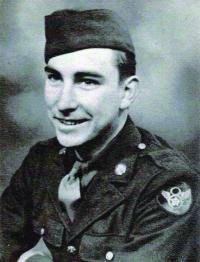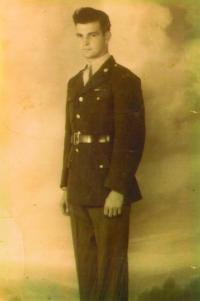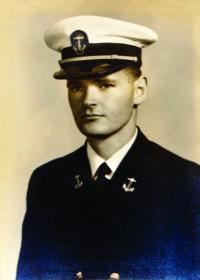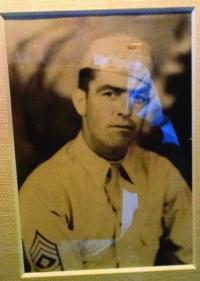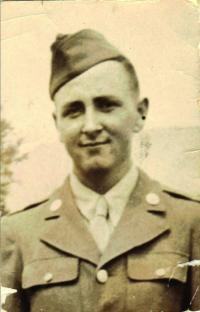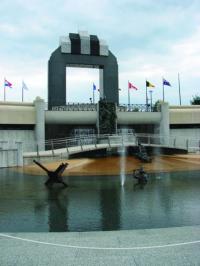TODAY, June 6, 2014, the 70th Anniversary of the Allied Assault on the beaches of Normandy, France -“Operation Overlord” - will be commemorated at the D-Day Memorial, located in the small town of Bedford, in Virginia’s Shenendoah Valley.
The D-Day Memorial is located there, because Bedford was the home to Company A of the 116th Regiment of the 29th Division. The 29th Division - a National Guard Unit from Maryland and Virginia - and the First Division - Regular Army - landed at what had been designated as Omaha Beach in Normandy. They were commanded by Charles H. Gerhardt and Charles R. Huebner. Company A was the first of the 29'ers to land on Omaha Beach. By the end of the first day, their casualty rate exceeded 90 percent. Of the 32 Bedford Boys, 19 were lost. Bedford was a town of about 3,200. One of the Bedford Boys who did survive was a 19-year-old sergeant, J. Robert Slaughter, who was a founder and later Chairman of the National D-Day Memorial Commission. His bust was dedicated on Memorial Day.
The Normandy landing sites were divided, by the Allied High Command, into five beaches and given code names. From left to right, facing the beaches, were “Sword,” “Juno,” “Gold,” “Omaha” and “Utah.” The British Third Infantry Division, commanded by Major-General Tom Rennie, landed at Sword Beach. The 3rd Canadian Infantry Division, commanded by Major-General Rodney F.L. Keller assaulted Juno Beach. Gold Beach was assaulted by the British Northumbrian Infantry Division, commanded by Major-General Douglas Alexander Graham and the British 79th Armored Division, commanded by Major-General Sir Percy Hobart.
The Americans were assigned Omaha and Utah Beaches. The Fourth Infantry Division assaulted Utah Beach. Although the Division’s commander was Major General Raymond O. Barton, the Division was led ashore by Brigadier-General Theodore Roosevelt III, son of President Theodore Roosevelt and cousin of President Franklin Delano Roosevelt. General Roosevelt was among the first to land on Utah Beach. He was the oldest soldier to land on any beach that day and he was the only General to land by sea with the first wave of troops. Meanwhile, on Omaha Beach, his son - Captain Quintin Roosevelt II - was landing. On July 12th, General Roosevelt would die of a heart attack, and would later be awarded the Medal of Honor, posthumously. When his father was also posthumously awarded the Medal of Honor in 2001 for leading the “Rough Riders” at the Battle of San Juan Hill, outside of Santiago de Cuba, in the Spanish-American War, they became only the second father and son Medal of Honor winners - the first being the Generals MacArthur.
Prior to the sea-born landings, the All-American Paratroopers of the 82nd Airborne Division, commanded by Matthew Ridgeway, the Screaming Eagles of the 101st Airborne Division, commanded by General Maxwell D. Taylor - who was the first Allied general to land in France on D-Day - and the British 6th Airborne Division, commanded by Major-General Sir Richard N. Gale, dropped behind enemy lines.
German forces defending France were under the overall command of Field Marshal Gerd von Rundstedt, who was the Wehrmacht’s Senior Field Commander. The coastal defenses were under the command of Field Marshal Erwin Rommel, the erstwhile “Desert Fox.” German defenses were hampered by a number of factors. These included, in no particular order: a split of defensive strategy that was never really resolved; (2) lack of accurate intelligence; (3) overwhelming Allied command of the air; (4) overwhelming Allied materiel superiority; (5) overwhelming Allied command of the sea; (6) Hitler’s interference.
Manning the defenses along the coast were 716th and 709th Static Infantry Divisions, under the command of Lt. Generals Wilhelm Rickert and Karl-Wilhelm von Schlieben. These two divisions were not highly regarded by either side. They were composed of older men, men who were recovering from wounds, and “volunteers” from German occupied Soviet Union. For instance, the 709th Infantry Division contained two battalions of Georgian soldiers.
German high command never settled on a strategy to meet the invasion it knew was coming. Field Marshal von Rundstedt and most of the other officers advocated sucking the invaders in, surrounding them with German armor and annihilating them, as was done in Poland in 1939, France in 1940 and the Soviet Union in 1941. But Field Marshal Rommel knew better. He had served both in France and in North Africa. In France, he knew that the Luftwaffe had given the Wehrmacht air superiority. He had experienced what occurred in North Africa when the roles were reversed and the Allies dominated the air. He knew that German armor would not be free to roam at will, and surround the Allies, as was done earlier in the war. The Desert Fox advocated moving all available units onto the coast, because he felt that there would be one opportunity to defeat the invasion and that was at the coast. Once the invader was on the beach, given its materiel and aerial superiority, there would be no opportunity to throw it back. The resolution of this argument, of course, fell to Hitler, and he was unable to make a clear-cut decision. Reserving control of most of the Panzer units for himself, he placed them at a point where they could not easily get to the coast quickly.
To partly implement his theory, Field Marshal Rommel had, unbeknownst to the Allies, moved the 352nd Infantry Division, under the command of Lt. Gen. Dietrich Kriaiss, from St. Lô to Omaha Beach in March 1944. Although the division itself had not seen combat, it was rated as a first-rate division, because it had been constructed around a cadre of veteran NCOs and officers. It was composed primarily of boys from the Hannover region. It was they that would meet the boys from Virginia and Maryland on Omaha beach, on June 6, 1944. The 352nd was ready. It had plotted out the beach and constructed fields of fire so that there was no area that was not covered.
Following Company A onto Omaha, was Company B from Lynchburg. Company B had been assigned to Berlin by the War Department after the attack on Pearl Harbor. Company B’s duties were to guard the beach, since Worcester County was on the front line. One of the members of Company B, Dick Wright, dated the late Eunice Q. Sorin. Another member of Company B, the late Roland Horton, is survived by a nephew, Raymond R. Land, retired member of the Ocean City Police Department’s Mounted Unit. Although wounded, Mr. Horton did survive. Dick Wright did not, being killed on the beach, early on the morning of June 6.
Among those manning the landing craft that were transporting the soldiers to the beaches were Ensign Hamilton P Fox, who would later serve as the State’s Attorney for Wicomico County and Motor Machinist Mate, 2nd Class Nathanael L. Henry, who was awarded his second Silver Star for his bravery that day and whose son, retired Maryland State Trooper, Marvin, contributes to this column. Both men went ashore to help wounded aboard their craft to transport them to safety. Machinist Mate Henry related to his son that the bilge pumps were expelling 80 percent blood when within 50 yards of the beach.
Sgt. Hiram H. Collins of Crisfield was killed when a German shell hit his landing craft, killing all aboard. His body was never recovered, but his brother, the late James Edward “Scoop” Collins, Sr., named his middle son, Thomas Hiram Collins, who perpetuates his uncle’s memory in the name of his restaurant in Vero Beach, Florida - Capt. Hiram’s - where his photo and Purple Heart are displayed.
Because of the 352nd, the situation at Omaha Beach was touch and go. The American soldiers had been told that there really was no reason for concern, because the enemy units defending the beaches were comprised of second-rate soldiers - old men and former POWs. They were also told that the aerial bombardment would be so devastating that no one could possibly survive it and if that didn’t do the trick, then the Naval bombardment from the huge guns on the battleships would surely do it and certainly if nothing else, there would be plenty of shell craters and bomb craters in which to take cover. Unfortunately, both the aerial and naval bombardment missed by a mile, so that the defenders were not affected, the 352nd was a first rate division and there were no shell craters.
Finally, at 10:00 a.m., someone was able to radio for Naval assistance and destroyers USS Frankford and USS McCook came within 800 yards and opened up at point blank range with their 5" guns. This, and the fact that the Germans began to run out of ammunition and were unable to resupply because of the bombardment, allowed the Americans to make progress to the interior. Also at 10:00 a.m., the 115th Regiment from the 29th Division - the Boys from Maryland - began coming ashore. Included in that regiment was local resident John Sauer, and the late Marion Massey, whose son was formerly Ocean City’s Police Chief, and who currently serves as Ocean Pines’ Police Chief. At noon of the next day, the 175th Regiment - from Baltimore - landed.
On D+3, James E. (“Snooks”) Lynch, who was a trigger man on an anti-aircraft unit consisting of four .50 cal. machine guns, mounted on a half-track, landed on Omaha Beach. He recalled that the first thing he saw was a cemetery. Early the next morning, the Second Battalion of the 115th Regiment was attacked by a German force and its commander, Lt. Col. Edwin Warfield, was killed. He is survived by his son, local realtor Robert E. Warfield, who was two when his father left home. He is buried at Colville Cemetery, above Omaha Beach, which is the setting for the opening and closing scenes of “Saving Private Ryan.”
NEXT: SAIPAN
Mr. Wimbrow writes from Ocean City, Maryland, where he practices law representing those persons accused of criminal and traffic offenses, and those persons who have suffered a personal injury through no fault of their own. Mr. Wimbrow can be contacted at
wimbrowlaw@gmail.com.
